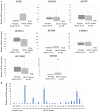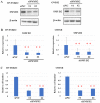The histone methyltransferase SMYD2 is a novel therapeutic target for the induction of apoptosis in ovarian clear cell carcinoma cells
- PMID: 32934721
- PMCID: PMC7471656
- DOI: 10.3892/ol.2020.12014
The histone methyltransferase SMYD2 is a novel therapeutic target for the induction of apoptosis in ovarian clear cell carcinoma cells
Abstract
Previous studies have suggested that histone methylation can modulate carcinogenesis and cancer progression. For instance, the histone methyltransferase SET and MYND domain containing 2 (SMYD2) is overexpressed in several types of cancer tissue. The aim of the present study was to determine whether SMYD2 could serve a therapeutic role in ovarian clear cell carcinoma (OCCC). Reverse transcription-quantitative PCR was used to examine SMYD2 expression in 23 clinical OCCC specimens. Moreover, OCCC cell proliferation and cell cycle progression were also examined following small interfering RNA-mediated SMYD2 silencing or treatment with a selective SMYD2 inhibitor. SMYD2 was significantly upregulated in clinical OCCC specimens, compared with normal ovarian tissue. In addition, SMYD2 knockdown decreased cell viability as determined via a Cell Counting Kit-8 assay. Moreover, the proportion of cells in the sub-G1 phase increased following SMYD2 knockdown, suggesting increased apoptosis. Treatment with the SMYD2 inhibitor LLY-507 suppressed OCCC cell viability. These results suggested that SMYD2 could promote OCCC viability, and that SMYD2 inhibition induced apoptosis in these cells. Thus, SMYD2 inhibitors may represent a promising molecular targeted approach for OCCC treatment.
Keywords: SMYD2; SMYD2 selective inhibitor; epigenetic modification; histone methyltransferase; ovarian clear cell carcinoma.
Copyright: © Kojima et al.
Figures




Similar articles
-
Histone methyltransferase SMYD2 selective inhibitor LLY-507 in combination with poly ADP ribose polymerase inhibitor has therapeutic potential against high-grade serous ovarian carcinomas.Biochem Biophys Res Commun. 2019 May 28;513(2):340-346. doi: 10.1016/j.bbrc.2019.03.155. Epub 2019 Apr 4. Biochem Biophys Res Commun. 2019. PMID: 30955858
-
The histone methyltransferase WHSC1 is regulated by EZH2 and is important for ovarian clear cell carcinoma cell proliferation.BMC Cancer. 2019 May 15;19(1):455. doi: 10.1186/s12885-019-5638-9. BMC Cancer. 2019. PMID: 31092221 Free PMC article.
-
LLY-507, a Cell-active, Potent, and Selective Inhibitor of Protein-lysine Methyltransferase SMYD2.J Biol Chem. 2015 May 29;290(22):13641-53. doi: 10.1074/jbc.M114.626861. Epub 2015 Mar 30. J Biol Chem. 2015. PMID: 25825497 Free PMC article.
-
Histone methyltransferase SMYD2: ubiquitous regulator of disease.Clin Epigenetics. 2019 Aug 1;11(1):112. doi: 10.1186/s13148-019-0711-4. Clin Epigenetics. 2019. PMID: 31370883 Free PMC article. Review.
-
Novel insights into SMYD2 and SMYD3 inhibitors: from potential anti-tumoural therapy to a variety of new applications.Mol Biol Rep. 2021 Nov;48(11):7499-7508. doi: 10.1007/s11033-021-06701-6. Epub 2021 Sep 12. Mol Biol Rep. 2021. PMID: 34510321 Review.
Cited by
-
Mechanistic and functional extrapolation of SET and MYND domain-containing protein 2 to pancreatic cancer.World J Gastroenterol. 2022 Aug 7;28(29):3753-3766. doi: 10.3748/wjg.v28.i29.3753. World J Gastroenterol. 2022. PMID: 36157542 Free PMC article. Review.
-
Unveiling Smyd-2's Role in Cytoplasmic Nrf-2 Sequestration and Ferroptosis Induction in Hippocampal Neurons After Cerebral Ischemia/Reperfusion.Cells. 2024 Nov 28;13(23):1969. doi: 10.3390/cells13231969. Cells. 2024. PMID: 39682718 Free PMC article.
-
SMYD family in cancer: epigenetic regulation and molecular mechanisms of cancer proliferation, metastasis, and drug resistance.Exp Mol Med. 2024 Nov;56(11):2325-2336. doi: 10.1038/s12276-024-01326-8. Epub 2024 Nov 1. Exp Mol Med. 2024. PMID: 39482529 Free PMC article. Review.
-
Review the progression of ovarian clear cell carcinoma from the perspective of genomics and epigenomics.Front Genet. 2023 Feb 16;14:952379. doi: 10.3389/fgene.2023.952379. eCollection 2023. Front Genet. 2023. PMID: 36873929 Free PMC article. Review.
-
Epigenetic regulation of SMAD3 by histone methyltransferase SMYD2 promotes lung cancer metastasis.Exp Mol Med. 2023 May;55(5):952-964. doi: 10.1038/s12276-023-00987-1. Epub 2023 May 1. Exp Mol Med. 2023. PMID: 37121971 Free PMC article.
References
-
- Serov SF, Scully R, Sobin LH. Geneva: World Health Organization; 1973. Histologic typing of ovarian tumors.
-
- Takano M, Sugiyama T, Yaegashi N, Sakuma M, Suzuki M, Saga Y, Kuzuya K, Kigawa J, Shimada M, Tsuda H, et al. Low response rate of second-line chemotherapy for recurrent or refractory clear cell carcinoma of the ovary: A retrospective Japan Clear Cell Carcinoma Study. Int J Gynecol Cancer. 2008;18:937–942. doi: 10.1111/j.1525-1438.2007.01158.x. - DOI - PubMed
-
- Varier RA, Timmers HT. Histone lysine methylation and demethylation pathways in cancer. Biochim Biophys Acta. 2011;1815:75–89. - PubMed
LinkOut - more resources
Full Text Sources
